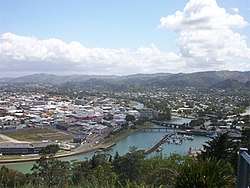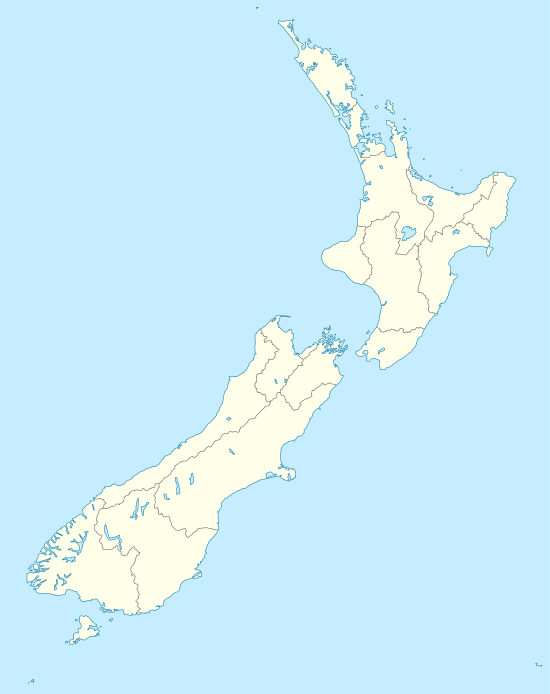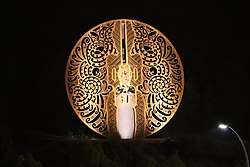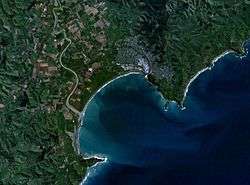Gisborne, New Zealand
Gisborne (Māori: Tūranga-nui-a-Kiwa "Great standing place of Kiwa") is a city in northeastern New Zealand and the largest settlement in the Gisborne District (or Gisborne Region). It has a population of 35,500 (June 2019).[1] The district council has its headquarters in Whataupoko, in the central city.
Gisborne | |
|---|---|
City | |
 Central and northeastern Gisborne viewed from Kaiti Hill | |
 Gisborne Location in New Zealand | |
| Coordinates: 38°39′45″S 178°1′4″E | |
| Country | New Zealand |
| Region | Gisborne Region |
| Government | |
| • Mayor | Rehette Stoltz |
| Population (June 2019)[1] | |
| • Total | 35,500 |
| Time zone | UTC+12 (NZST) |
| • Summer (DST) | UTC+13 (NZDT) |
| Area code(s) | 06 |
| Website | GDC.govt.nz |
The settlement was originally known as Turanga and renamed Gisborne in 1870 in honour of New Zealand Colonial Secretary William Gisborne.[2]
Early history
First arrivals
The Gisborne region has been settled for over 700 years.[3] For centuries the region has been inhabited by the tribes of Te Aitanga-a-Māhaki, Rongowhakaata, Ngāi Tāmanuhiri and Te Aitanga-a-Hauiti. Their people descend from the voyagers of the Te Ikaroa-a-Rauru, Horouta and Tākitimu waka.[4]
East Coast oral traditions offer differing versions of Gisborne's establishment by Māori. One legend recounts that in the 1300s, the great navigator Kiwa landed at the Turanganui River first on the waka Tākitimu after voyaging to the region from Hawaiki[5][6] and that Pāoa, Captain of the waka Horouta, followed later. An alternative legend recounts that Kiwa waited so long for the Horouta canoe to arrive that he called its final landing place Tūranganui-a-Kiwa (The long waiting place of Kiwa).[7]
However, a more popular version of events is that Horouta preceded Takitimu. In 1931, Sir Āpirana Ngata stated that Horouta was the main canoe that brought the people to the East Coast and that Ngāti Porou always regarded Takitimu as "an unimportant canoe".[8] Māori historian Rongowhakaata Halbert affirmed this account, stating that Paoa's crew on the Horouta were the first inhabitants of the East Coast after migrating from Ahuahu or Great Mercury Island.[9][10] Paoa gave his name to various places across the region, most notably the Waipāoa River (Wai-o-Pāoa).[4]
During the 14th century, Māori tribes built fishing villages close to the sea and built pā on nearby hilltops.[6]
Captain Cook landing

Gisborne's Kaiti Beach is the place where British navigator Captain James Cook made his first landing in New Zealand upon the Endeavour.[11] Cook had earlier set off from Plymouth, England in August 1768 on a mission bound for Tahiti. Once he had concluded his duties in Tahiti, Cook continued south to look for a large landmass or continent.[7][12] Young Nick's Head was thought to be the first piece of New Zealand land sighted by Cook's party, and so named because it was first observed by cabin boy Nicholas Young on 6 October 1769.[13]
On 9 October, Cook came ashore on the eastern bank of the Turanganui River, accompanied by a party of men.[7] Their arrival was marred by misunderstanding and resulted in the death and wounding of nine Māori over four days. It was also on the banks of the Turanganui River that first the township of Turanga, then the city of Gisborne, grew as European traders and whalers began to settle in the river and port area.[6][14]
The landing site was commemorated by a monument in 1906, on the 137th anniversary of Cook's arrival. In 1964 the Gisborne committee of the New Zealand Historic Places Trust registered the land around the monument as a historic reserve, and in 1990 it was designated a National Historic Reserve and put under the care of the Department of Conservation.[12][15]
In 2019 a memorial was erected by Ngāti Oneone on Titirangi, a local hill, to honour Te Maro who was one of the first casualties of the arrival of the ship Endeavour.[16]
European settlement and town growth
Starting in the early 1830s, traders such as Captain John Harris and Captain George E. Read set up the first trading stations along the Turanganui river and are attributed to the founding of the town. Over the next 30 years, many more European traders and missionaries migrated to the region. In 1868 the government bought 300 hectares of land for a town site. The town was laid out in 1870 and the name changed from Turanga to Gisborne, after the then colonial secretary, and to avoid confusion with Tauranga. In 1872, Gisborne's first public school was opened and its first newspaper, the Poverty Bay Standard was established.[10] A town council was formed in 1877.[2][6]
Geography

Gisborne is a coastal city located on the east cape of New Zealand's North Island. It sits at the south end of the Gisborne District and also within Poverty Bay. The Poverty Bay Flats encompass Gisborne city as well as surrounding areas Mākaraka, Matawhero and Ormond where vineyards and farms are prominent.[17] Gisborne is flat towards the shoreline, but forested and hilly inland.[18]
Gisborne boasts a large stretch of coastline encompassing the Waikanae and Midway, Kaiti, Sponge Bay, Wainui and Makorori white sand beaches, which are popular for swimming and surfing.[19]
Sometimes referred to as the 'City of Rivers', Gisborne sits at the convergence of the Waimata, Taruheru and Turanganui rivers.[20] At only 1200 meters long, Turanganui is the shortest river in New Zealand.[21]
Kaiti Hill (Titirangi), which sits directly above Cook's landing site,[22] provides expansive views over the city and wider Poverty Bay.[23] Many archaeological sites have been identified on Titirangi, including burial grounds, terraces, and middens. Titirangi Pā sits near the summit.[24]
In the wider area surrounding Gisborne are two arboreta, Eastwoodhill, the National Arboretum of New Zealand at Ngatapa which spans over 130 hectares, and the smaller 50 hectare Hackfalls Arboretum at Tiniroto.[25][26]
Up until Samoa and Tokelau's dateline shift in December 2011, Gisborne claimed to be the first city on Earth to see the sun rise each day. However, this is now only accurate in New Zealand's summer months.[27]
Climate
The region is sheltered by high country to the west. Gisborne enjoys a Temperate oceanic climate (Cfb - Köppen climate classification) with warm summers and cool winters, temperatures rarely drop below 0 °C (32 °F) and occasionally rise above 30 °C (86 °F)[28] with a yearly average of 2,200 sunshine hours. The annual rainfall varies from about 1000 mm near the coast to over 2500 mm in higher inland country.[29] According to the NIWA dataset for 1981–2010 normals, Gisborne narrowly edged several other cities to have the warmest summer maxima of official stations.[30] Winters are slightly cooler than more northerly areas, rendering that over the course of the calendar year, Gisborne is not the warmest station of the country.[31] Even summertime mean temperatures are lower than northerly areas in spite of the highs due to the cooler nights. In spite of this, yearly mean temperatures are still some way above average for New Zealand as a whole.
| Climate data for Gisborne (1981-2010 normals) | |||||||||||||
|---|---|---|---|---|---|---|---|---|---|---|---|---|---|
| Month | Jan | Feb | Mar | Apr | May | Jun | Jul | Aug | Sep | Oct | Nov | Dec | Year |
| Record high °C (°F) | 38.1 (100.6) |
36.6 (97.9) |
35.1 (95.2) |
28.2 (82.8) |
26.1 (79.0) |
23.2 (73.8) |
21.2 (70.2) |
22.0 (71.6) |
24.9 (76.8) |
30.8 (87.4) |
32.3 (90.1) |
34.5 (94.1) |
38.1 (100.6) |
| Average high °C (°F) | 24.9 (76.8) |
24.2 (75.6) |
22.6 (72.7) |
19.9 (67.8) |
17.1 (62.8) |
14.7 (58.5) |
14.1 (57.4) |
14.9 (58.8) |
16.8 (62.2) |
19.0 (66.2) |
21.3 (70.3) |
23.3 (73.9) |
19.5 (67.1) |
| Daily mean °C (°F) | 19.2 (66.6) |
19.1 (66.4) |
17.5 (63.5) |
14.8 (58.6) |
12.5 (54.5) |
10.3 (50.5) |
9.7 (49.5) |
10.4 (50.7) |
12.0 (53.6) |
13.9 (57.0) |
15.8 (60.4) |
18.1 (64.6) |
14.5 (58.1) |
| Average low °C (°F) | 13.6 (56.5) |
13.6 (56.5) |
12.2 (54.0) |
9.6 (49.3) |
6.9 (44.4) |
5.3 (41.5) |
4.6 (40.3) |
5.4 (41.7) |
6.8 (44.2) |
8.6 (47.5) |
10.5 (50.9) |
12.3 (54.1) |
9.1 (48.4) |
| Record low °C (°F) | 3.7 (38.7) |
3.6 (38.5) |
2.6 (36.7) |
0.5 (32.9) |
−1.3 (29.7) |
−3.3 (26.1) |
−3.2 (26.2) |
−2.4 (27.7) |
−1.1 (30.0) |
−0.6 (30.9) |
1.2 (34.2) |
2.9 (37.2) |
−3.3 (26.1) |
| Average precipitation mm (inches) | 54 (2.1) |
78 (3.1) |
99 (3.9) |
103 (4.1) |
97 (3.8) |
125 (4.9) |
119 (4.7) |
93 (3.7) |
101 (4.0) |
63 (2.5) |
65 (2.6) |
67 (2.6) |
1,050 (41.3) |
| Mean monthly sunshine hours | 249.9 | 200.7 | 190.7 | 164.9 | 145.6 | 128.6 | 124.1 | 163.3 | 180.7 | 219.4 | 217.5 | 232.4 | 2,217.7 |
| Source 1: NIWA Climate Data[32] | |||||||||||||
| Source 2: Météo Climat [33] | |||||||||||||
Economy
The harbour was host to many ships in the past and had developed as a river port to provide a more secure location for shipping compared with the open roadstead of Poverty Bay which can be exposed to southerly swells. A meat works was sited beside the harbour and meat and wool were shipped from here. Now the harbour is the home of many smaller fishing boats as well as ships loading logs for export.
The city maintains a rural charm and is a popular holiday spot. Local industries include agriculture, horticulture, farming and forestry. Wine production is also valuable to the local economy.
Lifestyle
Art and culture
Gisborne is home to a large Māori population, with 48.9% of the population identifying as Māori, compared to the national average of 14.9%.[34] Te Poho-o-Rawiri and Te Kuri a Tuatai marae are located in the city suburbs. The Tairāwhiti Tamararo Regionals are an annual regional haka competition held in Gisborne in memory of Karaitiana Tamararo.[35]
Gisborne is host to Rhythm & Vines, an annual 3-day music festival held over the New Year at Waiohika Estate. In 2012 and 2013, Rhythm and Vines made skinny dipping world record attempts.[36]
The Lowe Street Museum was the first museum in Gisborne, located in the Lowe Street Municipal Offices. In 1955 the collection of Māori artefacts of William Lysner were put in his former residence, Lysner House, which was sold to the city for a nominal sum. It is now known as the Tairāwhiti Museum.[37]
Sport
- In rugby union Gisborne is home to Poverty Bay Rugby Football Union, who play in the Heartland Championship. The city is also home to several clubs who compete in the Poverty Bay competition - Horouta Sports Club, High School Old Boys (HSOB) Sports Club, Old Boys Marist (OBM) RFC, Pirates RFC, Waikohu Sports Club, and Young Māori Party (YMP) RFC. There are several other clubs in the wider Gisborne Region.
- In rugby league, Gisborne Taraiwhiti have historically represented Gisborne in national competitions. Gisborne is currently represented in the National Competition by the Waicoa Bay Stallions.
- In cricket, Gisborne is home to the Poverty Bay Cricket Association, who compete in the Hawke Cup. Poverty Bay is also a district association of the Northern Districts Cricket Association. First-class matches are sometimes held at Harry Barker Reserve. Clubs in the city include High School Old Boys (HSOB) Cricket Club and OBR Cricket Club.
- In football, Gisborne Thistle AFC, Gisborne Marist AFC, Gisborne United AFC, Gisborne Bohemians FC, and Riverina AFC compete in competitions organised by the Central Football Federation. The now-defunct Gisborne City AFC won the Chatham Cup in 1987.
- Netball in Gisborne is organised by the Gisborne Netball Centre. Netball teams in Gisborne are often associated with rugby or football clubs. Clubs include Horouta, High School Old Girls (HSOG), Old Boys Marist (OBM), Young Māori Party (YMP), and Gisborne Thistle.
- A number of other sports, including golf, basketball, rowing, hockey, tennis, and squash are catered to in Gisborne.
Demographics
| Year | Pop. | ±% |
|---|---|---|
| 1986 | 45,758 | — |
| 1991 | 44,361 | −3.1% |
| 1996 | 45,962 | +3.6% |
| 2001 | 43,971 | −4.3% |
| 2006 | 44,463 | +1.1% |
| 2013 | 43,656 | −1.8% |
Gisborne, which in Statistics New Zealand census records is coterminous with Gisborne District, had a population of 43,656 according to the 2013 census. This is a decrease of 807, or 1.8 percent, since the 2006 census. There were 16,185 occupied dwellings, 1,824 unoccupied dwellings, and 51 dwellings under construction.[38]
Of the residential population, 21,093 (48.3%) were male compared to 48.7% nationally, and 22,560 (51.7%) were female, compared to 51.3% nationally. The city had a median age of 37.0 years, 1.0 years below the national median age of 38.0 years. People aged 65 and over made up 14.0% of the population, compared to 14.3% nationally, and people under 15 years made up 24.6%, compared to 20.4% nationally. People aged between 15 and 24 made up approximately 12.7% of the city's residential population.[38]
Gisborne's ethnicity is made up of (national figures in brackets): 56.1% European (74.0%), 45.1% Māori (14.9%), 2.2% Asian (11.8%), 3.5% Pacific Islanders (7.4%), 0.4% Middle Eastern, Latin American or African (1.2%), 1.4% 'New Zealanders' (1.6%), and 0.05% Other (0.1%).[38]
Gisborne had an unemployment rate of 9.4% of people 15 years and over, compared to 7.4% nationally. The median annual income of all people 15 years and over was $24,400, compared to $28,500 nationally. Of those, 41.9% earned under $20,000, compared to 38.2% nationally, while 19.6% earned over $50,000, compared to 26.7% nationally.[38]
Gisborne has the smallest percentage of population born overseas at 9.7% compared to 25.2% for New Zealand as a whole.[40] The highest of these are British totalling 1,335 or 3.1% of the population.[41] Furthermore, 73.0% of the population could speak in one language only, 16.2% in two languages and 1.1% in three or more languages.[38]
Education
Gisborne City has four main high (secondary) schools: Gisborne Boys' High, Gisborne Girls' High, Lytton High and Campion College. Campion College is a Catholic co-educational school.
Transport
Air
Gisborne Airport serves as the domestic airport for the Gisborne Region. Regular flights between Auckland and Wellington are serviced by Air New Zealand under the Link brand, while the smaller airline Sunair provides services to other New Zealand centres such as Hamilton, Whakatāne, Rotorua and Tauranga, and Air Napier provides services to Napier and Wairoa.
Highways
![]()
![]()

Public transport
Public transport is poorly developed in Gisborne, with only 0.2% of trips made by bus in 2013/14. This compares with 2.3% nationally,[42] which itself is amongst the lowest proportions in the world.[43] Go Bus is contracted to the council to run 22 services a day on 6 routes Monday to Friday,[44] using 2 buses.[45] From 1913 to 1929 Gisborne had battery-powered trams. Since then public transport has declined to about a fifth of the usage then. In 1930 the municipal buses travelled 6,631 mi (10,672 km), and carried 28,531 passengers in 2 weeks.[46] In 2012/13 the city buses carried about 78,000 passengers in 52 weeks, at a cost of about $120,000 a year, with about another $85,000 from fares.[47]
Rail
Gisborne is the northern terminus of the Palmerston North - Gisborne Line railway, which opened in 1942 and mothballed (track kept in place but all services cancelled) in 2012. The permanent way has since suffered storm damage including bridge collapses and the line is believed unlikely to re-open for economic reasons. Prior to this, an isolated section of line operated from Gisborne to Moutohora – intended to be part of a line to Auckland via Rotorua, and later part of the East Coast Main Trunk Railway line. This connection was never completed and the Moutohora Branch line closed in 1959.
Rail passenger services were provided between Gisborne and Wellington until 1988, when the Endeavour express was cancelled north of Napier. Today, only the Gisborne City Vintage Railway operates limited heritage train rides out of Gisborne.
Port
In February 2018 the first grants from the Provincial Growth Fund included $2.3 million for the Gisborne port.[48]
Suburbs

- Awapuni
- Elgin
- Gaddums Hill
- Heatherlea/Darwin Road
- Inner Kaiti
- Kaiti
- Makaraka
- Manutuke
- Mangapapa
- Makorori
- Riverdale
- Riverside
- Riverview
- Sponge Bay
- Tamarau
- Te Hapara
- Te Wharau
- Victoria[49]
- Waikanae
- Waikirikiri
- Wainui Beach
- Whataupoko
In popular culture
Gisborne City was the setting of the 2014 drama film The Dark Horse, a biographical film starring Cliff Curtis about the late speed-chess champion, Genesis Potini. The film was shot in Gisborne and Auckland in the winter of 2013.[50]
In March 2016, Gisborne hosted the premiere of Mahana, a New Zealand film set in Patutahi and Manutuke, and based on Witi Ihimaera's semi-autobiographical novel Bulibasha: King Of The Gypsies.[51]
Sister cities
Gisborne has four sister cities, a sister port, and five friendly cities.[52]




Friendly cities

.svg.png)



References
- "Subnational Population Estimates: At 30 June 2019". Statistics New Zealand. 22 October 2019. Retrieved 11 January 2020.
- Monty Soutar (25 March 2015). "East Coast places – Gisborne". Te Ara – the Encyclopedia of New Zealand. Retrieved 28 May 2016.
- "History of Gisborne – Lonely Planet Travel Information". Lonely Planet. Retrieved 28 May 2016.
- "Story: Tūranganui-a-Kiwa tribes". Te Ara – The Encyclopedia of New Zealand. Retrieved 28 May 2016.
- "The People – History". Te Runanga o Turanganui a Kiwa. Retrieved 28 May 2016.
- "Gisborne History". Tairāwhiti Tours. Retrieved 28 May 2016.
- Spedding, Michael (October 2006). The Turanganui River: A Brief History (PDF). Department of Conservation in association with NZ Historic Places Trust, Tairawhiti Museum and Eastland Port Co. Ltd. pp. 13–29. ISBN 0-478-14120-3. Retrieved 28 May 2016.
- Tairawhiti Māori Association (1932). Echoes of the Pa: Tairawhiti Māori Association's Research Proceedings 1931–1932. Gisborne Publishing Co.
- Halbert, Rongowhakaata (1999). "The Horouta Canoe". Horouta : the history of the Horouta canoe, Gisborne and East Coast. Reed, Auckland, N.Z. pp. 26–28. ISBN 0790006235.
- Mackay, Joseph Angus (1949). Historic Poverty Bay and the East Coast, N.I., N.Z.
- "Our district's history". Gisborne District Council. Retrieved 28 May 2016.
- "Historic Cook Landing Site". Department of Conservation. Retrieved 28 May 2016.
- Cyclopedia Company Limited (1902). "The Cyclopedia of New Zealand [Auckland Provincial District]". The Cyclopedia Company: 960–1002. Retrieved 28 May 2016. Cite journal requires
|journal=(help) - "Tūranganui-a-Kiwa tribes: Contacts and conflicts". Te Ara – The Encyclopedia of New Zealand. Retrieved 28 May 2016.
- Nancy Swarbrick (12 August 2014). "Public history – Historic places and objects". Te Ara – the Encyclopedia of New Zealand. Retrieved 28 May 2016.
- Dewes, Marama. "Ngāti Oneone re-tell accurate history of Gisborne". Māori Television. Retrieved 31 December 2019.
- Soutar, Monty (25 March 2015). "East Coast places – Poverty Bay flats". Te Ara – the Encyclopedia of New Zealand. Retrieved 12 June 2016.
- "Holiday hotspot face-off: Bay of Plenty vs Gisborne". Stuff. Retrieved 12 June 2016.
- Peryman, Bailey (June 2011). "Surf Break Identification and Protection in the Gisborne District" (PDF). Gisborne District Council. Retrieved 12 June 2016.
- Soutar, Monty (15 November 2012). "East Coast places – Gisborne". Te Ara – the Encyclopedia of New Zealand. Retrieved 12 June 2016.
- "Our District". Gisborne District Council. Retrieved 14 January 2011.
- "Cook Landing Site National Historic Reserve" (PDF). Department of Conservation (Te Papa Atawhai). Retrieved 12 June 2016.
- "Introducing Titirangi Reserve" (PDF). Gisborne District Council. Retrieved 12 June 2016.
- "Plans revealed for Kaiti Hill-Titirangi". The Gisborne Herald. 11 May 2016. Retrieved 12 June 2016.(subscription required)
- McCarroll, Jo (22 April 2016). "Gardens to visit around Gisborne". New Zealand Gardener. Stuff. Retrieved 12 June 2016.
- "Eastwoodhill – The National Arboretum of New Zealand". Eastwoodhill. Retrieved 12 June 2016.
- Handford, Roger (4 January 2012). "Gisborne still first for the sun". The New Zealand Herald. Retrieved 11 June 2016.
- "Climate Gisborne: Temperature, Climograph, Climate table for Gisborne - Climate-Data.org". en.climate-data.org. Retrieved 25 October 2017.
- "Gisborne Weather". Archived from the original on 16 July 2011.
- "Mean Daily Maximum Temperatures (°C)". NIWA. Retrieved 14 March 2015.
- "Mean monthly temperatures (°C)". NIWA. Retrieved 14 March 2015.
- "Climate Data". NIWA. Retrieved 14 November 2011.
- "Météo climat stats Records for Gisborne". Météo Climat. Retrieved 25 March 2017.
- "QuickStats about Gisborne District" (PDF). Statistics New Zealand. 2013. Retrieved 12 June 2016.
- Brown, Harata (24 April 2016). "5 teams to represent Te Tairāwhiti at Te Matatini". Māori Television. Retrieved 12 June 2016.
- "Hundreds get their gear off in Gisborne". Television New Zealand. 31 December 2013.
- "Museum History". Tairawhiti Museum. Tairāwhiti Museum. Retrieved 27 December 2018.
- "2013 Census tables about a place: Gisborne District". Statistics New Zealand. Retrieved 1 February 2016.
- "1996 Census of Population and Dwellings – Census Night Population". Statistics New Zealand. 28 February 1997. Archived from the original on 13 February 2016. Retrieved 1 February 2016.
- "2013 Census QuickStats about culture and identity – Birthplace and people born overseas". Statistics New Zealand. Retrieved 23 January 2016.
- "Birthplace (detailed), for the census usually resident population count, 2001, 2006, and 2013 (RC, TA) – NZ.Stat". Statistics New Zealand. Retrieved 1 February 2016.
- "Travel patterns : Household travel | Ministry of Transport". www.transport.govt.nz. Retrieved 30 April 2016.
- "Transport, 2007 | OECD READ edition". OECD iLibrary. Retrieved 30 April 2016.
- "Gisborne District Council " GizzyBus timetable". www.gdc.govt.nz. Retrieved 29 June 2016.
- "Gisborne District Council " GizzyBus service". www.gdc.govt.nz. Retrieved 29 June 2016.
- "News in Brief". Otago Daily Times. 10 December 1930. p. 16. Retrieved 29 June 2016.
- "Gisborne Regional Public Transport Plan 2013–2016" (PDF).
- "Shane Jones doles out millions to Northland, Hawkes Bay and (to) rail regeneration". Stuff (Fairfax). 23 February 2018.
- McLintock, A.H. (ed.) (1959) A descriptive atlas of New Zealand. Wellington: NZ Government Printer. Map 31.
- Walsh, Kristine (2 April 2016). "Glowing reviews as Dark Horse hits US". The Gisborne Herald. Retrieved 12 June 2016.
- Treacher, Aroha (4 March 2016). "Gisborne turns on glitz for Mahana premiere". Māori Television. Retrieved 12 June 2016.
- "Sister Cities". Gisborne District Council. Retrieved 22 February 2019.
External links
| Wikivoyage has a travel guide for Gisborne. |
| Wikimedia Commons has media related to Gisborne. |
- Gisborne District Council official website
- Tourism Eastland
- Historic Poverty Bay and the East Coast, N.I., N.Z., (1949) Joseph Angus Mackay